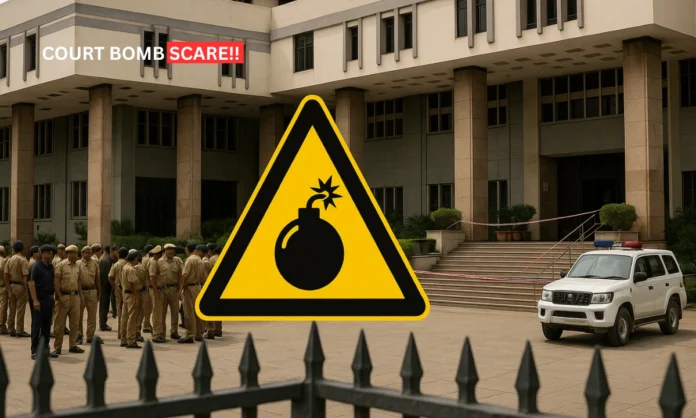Key Highlights
- Both Delhi and Bombay High Courts evacuated on September 13, 2025, following email threats warning of planted explosive devices
- Security operations involved bomb disposal squads, dog units, and coordinated police response across two metropolitan centers
- Incidents reflect growing pattern of judicial security threats amid India’s strained justice system infrastructure
The dual Bombay High Court bomb threat targeting India’s premier high courts on Friday represent an alarming escalation in security concerns affecting the nation’s judicial infrastructure. The synchronized threats against Delhi and Bombay High Courts forced immediate evacuations and exposed vulnerabilities in a justice system already grappling with severe capacity constraints.
Bombay High Court Bomb Threat: Swift Security Response Mobilizes Across Two Cities
The first threat materialized at Delhi High Court around 8:39 AM when Registrar General Arun Bhadwaj received an email warning that three bombs had been planted in judges’ chambers and courtrooms. The message demanded complete evacuation by 2 PM and specifically referenced detonation “shortly after Mid-Day Islamic prayers”. Security protocols activated immediately, with judges abruptly rising from their benches around 11:15 AM as proceedings came to an unprecedented halt.
Mumbai authorities faced a parallel crisis when the Bombay High Court bomb threat email arrived later that afternoon. Chief Justice Chandrashekhar ordered an immediate evacuation, with judicial officers, legal practitioners, and court staff streaming out through separate exits as bomb disposal teams mobilized. The Fort area court complex sealed its premises while specialized units conducted systematic searches of all judicial chambers and administrative areas.
Both operations demonstrated coordinated emergency response capabilities, deploying bomb detection and disposal squads alongside canine units and fire department personnel. Delhi Police Deputy Commissioner Devesh Kumar Mahla confirmed that standard operating procedures were followed, with thorough sanitization of all three Delhi High Court buildings completed by 1:40 PM.
Live – Security concern in Bombay High Court premises. Bar associations have requested member advocates to immediately vacate High Court premises in south Mumbai owing to security concerns due to bomb threat. Courtrooms are vacated and lawyers vacating premises. pic.twitter.com/pldJ3d825r
— Mumbai Rains (@rushikesh_agre_) September 12, 2025
Bombay High Court Bomb Threat: Threatening Communications Reveal Sophisticated Planning
The Bombay High Court bomb threat email contained specific operational details suggesting careful advance planning by unknown perpetrators. The Delhi High Court message, sent from an account labeled “Kanimozhi Thevidiya,” included references to Pakistan ISI connections and threats against political figures including Udhayanidhi Stalin’s son. The communication claimed to “recreate the 1998 Coimbatore blasts” while expressing extremist political ideologies about secular leadership transitions.
Investigation teams immediately began tracing the email origins through digital forensics and IP address analysis. Delhi Police registered a formal FIR at the Cyber Police Station on September 13, establishing a dedicated task force to identify the sender’s digital footprint. The sophisticated nature of the coordinated threats across two major metropolitan areas indicates potential involvement of organized networks rather than isolated incidents.
Officials noted that the threatening messages contained specific architectural knowledge of court layouts, mentioning judges’ chambers, courtroom configurations, and administrative areas. This level of detail raised concerns about possible insider knowledge or extensive reconnaissance activities preceding the Bombay High Court bomb threat deployment.
Bombay High Court Bomb Threat: India’s Overburdened Justice System Faces Critical Vulnerabilities
These security incidents occurred against the backdrop of India’s severely strained judicial infrastructure, which serves 1.4 billion citizens with only 21,285 judges—approximately 15 judges per million population. The National Judicial Data Grid reveals over 4.83 crore pending cases across district and subordinate courts, with 38% of cases pending for less than one year and 9% exceeding ten years.
The 2025 India Justice Report highlights critical capacity deficits affecting judicial security operations. High Court judge vacancies reach 33% nationally, while district court vacancies stand at 21%, creating excessive workloads that strain administrative resources. Some High Courts, including Allahabad and Madhya Pradesh, face caseloads exceeding 15,000 cases per judge, limiting attention to security protocols and infrastructure maintenance.
Budget allocations for judicial operations remain inadequate, with per capita spending on judiciary standing at only Rs 182 annually. No state allocates more than one percent of its total expenditure to judicial infrastructure, constraining security system upgrades and emergency response capabilities. The constrained resources affect both physical security measures and cybersecurity systems protecting court communications from external threats.
Bombay High Court Bomb Threat: Growing Pattern of Institutional Targeting Demands Enhanced Protection
Friday’s Bombay High Court bomb threat incidents represent part of an escalating pattern of bomb threats targeting critical Indian institutions throughout 2025. Over 30 similar threats have disrupted schools, hospitals, government buildings, and transportation facilities in recent months, indicating systematic attempts to destabilize public confidence in institutional security.
Recent examples include threats to Delhi’s Chief Minister Secretariat, medical colleges, and the Haryana Civil Secretariat in Chandigarh, all following similar email-based delivery methods. The Punjab and Haryana High Court received comparable threats on May 22, while the Taj Palace Hotel in Delhi faced evacuation orders just hours after the High Court incidents.
Security experts emphasize that these coordinated threats, while ultimately proven hoax attempts, consume substantial emergency response resources and create lasting psychological impacts on judicial personnel. The systematic targeting of India’s constitutional institutions requires enhanced cybersecurity protocols, improved threat assessment capabilities, and strengthened coordination between judicial administration and law enforcement agencies.
The dual Bombay High Court bomb threat incidents underscore the urgent need for comprehensive security reforms across India’s justice system infrastructure. As the nation’s courts continue processing millions of cases while operating under severe resource constraints, protecting judicial independence requires both immediate security enhancements and long-term capacity building to ensure uninterrupted access to constitutional justice.


